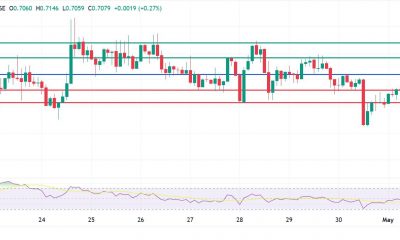

others
Australian Dollar seems to surpass the psychological level on a subdued US Dollar – Crypto News
- Australian Dollar retraces its losses on risk-on sentiment.
- Australian job advertisements improved by 0.1% in December from the 4.6% prior.
- PBoC former director Sheng Songchen stated that China’s property downturn might persist for another two years.
- US Dollar remains steady despite downbeat US bond yields.
The Australian Dollar (AUD) attempts to recover its losses on Monday after a decline in the previous two sessions. The Australian Dollar gains ground on a softer US Dollar (USD) amid subdued US Treasury yields. The market is anticipated to be relatively quiet regarding US economic data due to the observance of Martin Luther King Jr. Day on Monday.
Australia’s currency experienced upward support due to heightened market speculation about potential rate cuts by the US Federal Reserve (Fed) in March. This speculation gained momentum, especially after Barclays revised its forecast on Friday for the first Federal Reserve (Fed) rate cut, moving it up to March from June. In a note released on Friday, Barclays analysts expressed their expectation for the Federal Open Market Committee (FOMC) to reduce the Fed Funds rate by 25 basis points at the March meeting.
Australia’s job advertisements released by the Australia and New Zealand Banking Group Limited (ANZ) showed an improvement of 0.1% in December, swinging from the previous decline of 4.6%. Market participants are expected to closely observe the Westpac Consumer Confidence for January and the TD Securities Inflation for December, both scheduled for release on Tuesday. The focus will be shifted toward Consumer Inflation Expectations and labor market data on Thursday.
The People’s Bank of China’s (PBoC) former director Sheng Songchen stated at a forum in Shanghai on Saturday that the property downturn in China might persist for an additional two years before stabilizing, according to Bloomberg. He anticipates that new-home sales nationwide will likely decrease by another 50 million square meters in 2024 and 2025. The annual total for 2025 is expected to plateau around 850 million square meters.
The US Dollar Index (DXY) continues to gain ground for the third successive session. However, the softer Producer Price Index (PPI) data from the United States (US) on Friday might have contributed downward for the US Dollar. US Retail Sales data will be eyed on Wednesday.
Daily Digest Market Movers: Australian Dollar experiences gains on a risk-on mood
- Australia’s trade surplus increased to 11,437M MoM in December, surpassing the market expectation of 7,500M and exceeding the previous reading of 7,129M.
- Australian Monthly Consumer Price Index (YoY) for November showed a slight reduction to 4.3%, falling slightly short of the market expectation of 4.4% from the previous figure of 4.9%.
- Chinese Consumer Price Index (YoY) decreased by 0.3% in December, against the expected 0.4% decline. The monthly Consumer Price Index eased at 0.1%, compared to the market expectation of 0.2%. The yearly Producer Price Index fell by 2.7%, slightly exceeding the expected decline of 2.6%.
- Chinese Trade Balance in USD increased to $75.34B from the previous $68.39B, surpassing the expected $74.75B. The Exports (YoY) figure grew by 2.3%, exceeding the market consensus of 1.7%. The yearly Imports in CNY increased by 1.6%, compared to the previous 0.6%.
- US Bureau of Labor Statistics reported that the December Producer Price Index (PPI) figure was 1.0% year-on-year, compared to the previous reading of 0.8%. The Core PPI YoY arrived at 1.8%, down from 2.0% in November. Monthly, the headline and Core PPI indices remained flat at -0.1% and 0.0%, respectively.
- US Bureau of Labor Statistics reported that the Consumer Price Index (CPI) surged to 3.4% YoY in December, exceeding both November’s 3.1% and the anticipated market figure of 3.2%. The monthly CPI growth for December showed a 0.3% increase, surpassing the market analysts’ estimated projection of 0.2%. The annual Core CPI stood at 3.9%, a slight decrease from November’s 4.0%, while the monthly figure remained steady at 0.3%, in line with expectations.
Technical Analysis: Australian Dollar consolidates near 0.6700 psychological level
The Australian Dollar trades near 0.6690 on Monday, positioned below the psychological barrier at 0.6700 followed by the 14-day Exponential Moving Average (EMA) at 0.6721. A potential breakthrough above the EMA might propel the AUD/USD pair toward the key resistance at 0.6750. On the downside, crucial support lies at 0.6650, in conjunction with the 38.2% Fibonacci retracement level, situated at 0.6637.
AUD/USD: Daily Chart
Australian Dollar price today
The table below shows the percentage change of Australian Dollar (AUD) against listed major currencies today. Australian Dollar was the strongest against the New Zealand Dollar.
| USD | EUR | GBP | CAD | AUD | JPY | NZD | CHF | |
| USD | -0.04% | 0.00% | -0.03% | 0.03% | -0.03% | 0.06% | 0.01% | |
| EUR | 0.06% | 0.03% | -0.01% | 0.06% | 0.01% | 0.10% | 0.05% | |
| GBP | -0.01% | -0.03% | -0.04% | 0.02% | -0.02% | 0.07% | 0.02% | |
| CAD | 0.05% | 0.00% | 0.05% | 0.06% | 0.00% | 0.10% | 0.06% | |
| AUD | -0.03% | -0.06% | 0.00% | -0.05% | -0.03% | 0.05% | 0.01% | |
| JPY | 0.04% | -0.04% | -0.11% | -0.01% | 0.06% | 0.09% | 0.04% | |
| NZD | -0.06% | -0.13% | -0.07% | -0.11% | -0.05% | -0.09% | -0.05% | |
| CHF | 0.00% | -0.06% | -0.02% | -0.06% | 0.01% | -0.05% | 0.04% |
The heat map shows percentage changes of major currencies against each other. The base currency is picked from the left column, while the quote currency is picked from the top row. For example, if you pick the Euro from the left column and move along the horizontal line to the Japanese Yen, the percentage change displayed in the box will represent EUR (base)/JPY (quote).
RBA FAQs
The Reserve Bank of Australia (RBA) sets interest rates and manages monetary policy for Australia. Decisions are made by a board of governors at 11 meetings a year and ad hoc emergency meetings as required. The RBA’s primary mandate is to maintain price stability, which means an inflation rate of 2-3%, but also “..to contribute to the stability of the currency, full employment, and the economic prosperity and welfare of the Australian people.” Its main tool for achieving this is by raising or lowering interest rates. Relatively high interest rates will strengthen the Australian Dollar (AUD) and vice versa. Other RBA tools include quantitative easing and tightening.
While inflation had always traditionally been thought of as a negative factor for currencies since it lowers the value of money in general, the opposite has actually been the case in modern times with the relaxation of cross-border capital controls. Moderately higher inflation now tends to lead central banks to put up their interest rates, which in turn has the effect of attracting more capital inflows from global investors seeking a lucrative place to keep their money. This increases demand for the local currency, which in the case of Australia is the Aussie Dollar.
Macroeconomic data gauges the health of an economy and can have an impact on the value of its currency. Investors prefer to invest their capital in economies that are safe and growing rather than precarious and shrinking. Greater capital inflows increase the aggregate demand and value of the domestic currency. Classic indicators, such as GDP, Manufacturing and Services PMIs, employment, and consumer sentiment surveys can influence AUD. A strong economy may encourage the Reserve Bank of Australia to put up interest rates, also supporting AUD.
Quantitative Easing (QE) is a tool used in extreme situations when lowering interest rates is not enough to restore the flow of credit in the economy. QE is the process by which the Reserve Bank of Australia (RBA) prints Australian Dollars (AUD) for the purpose of buying assets – usually government or corporate bonds – from financial institutions, thereby providing them with much-needed liquidity. QE usually results in a weaker AUD.
Quantitative tightening (QT) is the reverse of QE. It is undertaken after QE when an economic recovery is underway and inflation starts rising. Whilst in QE the Reserve Bank of Australia (RBA) purchases government and corporate bonds from financial institutions to provide them with liquidity, in QT the RBA stops buying more assets, and stops reinvesting the principal maturing on the bonds it already holds. It would be positive (or bullish) for the Australian Dollar.
-

 Cryptocurrency1 week ago
Cryptocurrency1 week agoFirst 100 days under President Trump: crypto industry faces new challenges and opportunities – Crypto News
-

 Technology1 week ago
Technology1 week agoWaymo, Toyota Partner on Self-Driving Tech for Personal Vehicles – Crypto News
-

 Blockchain1 week ago
Blockchain1 week agoCrypto token failures soar, with 1 in 4 launched since 2021 dying in Q1: CoinGecko – Crypto News
-
Technology1 week ago
Here’s Why Shiba Inu Price May Skyrocket Soon – Crypto News
-

 Blockchain1 week ago
Blockchain1 week agoBitcoin Price Breakout Confirmed — Eyes on Next Key Level – Crypto News
-

 Technology1 week ago
Technology1 week agoOpenAI explains ‘THIS’ is why it reversed GPT-4o update amid sycophantic behavior concerns – Crypto News
-

 Cryptocurrency1 week ago
Cryptocurrency1 week agoCardano Price Finds $0.700 Support to Strengthen Upward Traction – Crypto News
-
Technology1 week ago
What’s Next for Bitcoin Price as BlackRock Moves to Launch $150B Fund? – Crypto News
-

 Technology1 week ago
Technology1 week agoGoogle’s Gemini AI could soon be built into iPhones, says CEO Sundar Pichai – Crypto News
-

 Technology1 week ago
Technology1 week agoAmazon Summer Sale 2025 is LIVE for Prime members: Up to 75% off on laptops, refrigerators, ACs and more – Crypto News
-
Cryptocurrency1 week ago
Cardano Founder Predicts What Next For Blockchain Innovation – Crypto News
-

 others1 week ago
others1 week agoAustralia’s Trade Surplus climbs to 6,900M MoM in March vs. 3,130M expected – Crypto News
-

 Technology1 week ago
Technology1 week agoAmazon Great Summer Sale is LIVE for Prime members: Big price drop of up to 45% on laptops across categories – Crypto News
-
Business1 week ago
Crypto Trader Made $300k As Solana-Based XAI Gork Price Skyrocket 191x, Here’s Why – Crypto News
-
others1 week ago
Bitcoin Price Prediction: BTC Eyes $145,000 Rally as Michael Saylor Launches Another $21B Plan – Crypto News
-
Business1 week ago
Here’s What to Expect From BTC, ETH, XRP & SOL as S&P500 Secretly Mirrors 1998 Cycle – Crypto News
-

 others1 week ago
others1 week agoUS State Paying $2,000,000,000 To Residents – No Strings Attached – in First-Ever ‘Inflation Rebate’ Program – Crypto News
-

 Cryptocurrency7 days ago
Cryptocurrency7 days agoXRP jumps 30% on Ripple news – Crypto News
-
Business1 week ago
North Carolina Approves Bill to Create Strategic Bitcoin Reserve Fund – Crypto News
-

 Cryptocurrency1 week ago
Cryptocurrency1 week agoShiba Inu, Ethereum prices waver as traders flock to this viral token – Crypto News
-

 Cryptocurrency1 week ago
Cryptocurrency1 week agoChainlink Price Prediction 2025-2027-2030: LINK To $1000? – Crypto News
-

 Cryptocurrency1 week ago
Cryptocurrency1 week ago$240M outflows amid tariff uncertainty – Crypto News
-

 Cryptocurrency1 week ago
Cryptocurrency1 week agoAnalysts Remain Bullish on Strategy’s Bitcoin Buying Plans – Crypto News
-
others1 week ago
Crypto Market Today: Top Trends Driving BTC, ETH, XRP & DOGE Prices – Crypto News
-
others1 week ago
Visa and Bridge Launches Stablecoin Payments In Latin America – Crypto News
-

 Cryptocurrency1 week ago
Cryptocurrency1 week agoBinance community vote puts FTT at highest delisting risk – Crypto News
-
Business1 week ago
WLD Price Eyes Breakout As Sam Altman’s Worldcoin Goes Live In US – Crypto News
-

 Blockchain1 week ago
Blockchain1 week agoWhy Saylor’s Billion-Dollar Bitcoin Buys Barely Move Price: Expert – Crypto News
-
others1 week ago
Kraken Q1 Performance Metrics Soar as IPO Hype Grows – Crypto News
-

 Cryptocurrency1 week ago
Cryptocurrency1 week agoTHREE reasons why Bitcoin is set to hit $107K next! – Crypto News
-

 others1 week ago
others1 week agoKey Fundamental Metrics for Memecoins in 2025 – Crypto News
-
Cryptocurrency1 week ago
Bitcoin ETFs Regain Momentum With $420M Inflow As BTC Price Eyes $100K – Crypto News
-
Technology1 week ago
Predicting Ethereum Price Target as ETH Mirrors Bitcoin’s Rally that Pushed it to $100k – Crypto News
-

 Cryptocurrency1 week ago
Cryptocurrency1 week agoRipple and SEC inch closer to resolution as April 16 looms – Crypto News
-

 others1 week ago
others1 week agoDow Jones soars 600 points as NFP data calms recession fears, weekly gains top 3% – Crypto News
-

 Cryptocurrency1 week ago
Cryptocurrency1 week agoFriday Charts: Will natural intelligence keep us employed? – Crypto News
-
Technology1 week ago
TRUMP Token as Reserve Asset? US Logistics Firm Freight Technologies To Hold TRUMP – Crypto News
-

 Blockchain1 week ago
Blockchain1 week agoPeter Brandt Predicts When Bitcoin Price Might Reach $150,000, Technical Signals Show Where Market Is At – Crypto News
-
Technology1 week ago
Bitcoin Price Eyes $100k as Saylor Buys $1.42B BTC — Fed Decision Looms – Crypto News
-

 others7 days ago
others7 days agoBullish momentum, buyers don’t give up – Crypto News
-
others5 days ago
Singapore Retail Sales (YoY) climbed from previous -3.6% to 1.1% in March – Crypto News
-
others5 days ago
Breaking: VanEck Files S1 Form With US SEC To Launch BNB ETF – Crypto News
-
others5 days ago
Breaking: VanEck Files S1 Form With US SEC To Launch BNB ETF – Crypto News
-
Technology5 days ago
ECB Kicks Off Digital Euro Testing with 70 Firms Across Europe – Crypto News
-

 Cryptocurrency5 days ago
Cryptocurrency5 days agoWill Bitcoin Fall Below $90K as Ethereum and XRP Lose Momentum? – Crypto News
-

 Business5 days ago
Business5 days agoRite Aid Files for Bankruptcy, Job Cuts Expected – Crypto News
-

 others1 week ago
others1 week agoBitMEX Founder Arthur Hayes Says Market Providing Stellar Entry Points for These Types of Protocols – Crypto News
-
Technology1 week ago
Ripple Offered $5 Billion To Buy USDC Issuer Circle: Bloomberg – Crypto News
-

 Blockchain1 week ago
Blockchain1 week agoFunding surge targets confidentiality, tokenization and Web3 infrastructure – Crypto News
-

 others1 week ago
others1 week agoAustralia’s Trade Surplus climbs to 6,900M MoM in March vs. 3,130M expected – Crypto News



![Nvidia will reveal its Q4 earnings today, after the bell [Video]](https://dripp.zone/news/wp-content/uploads/2025/02/Nvidia-will-reveal-its-Q4-earnings-today-after-the-bell-400x240.png)
![Nvidia will reveal its Q4 earnings today, after the bell [Video]](https://dripp.zone/news/wp-content/uploads/2025/02/Nvidia-will-reveal-its-Q4-earnings-today-after-the-bell-80x80.png)





